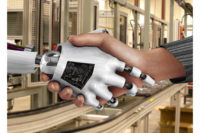
The goal of the project is to create vehicles that can help motorists better handle stressful driving situations.
But they are about to get even smarter now that an “augmented cognition research team” at theSandia National Nuclear Security Administrationlaboratory has begun creating cars capable of analyzing human behavior.
The project was started about 5 years ago with funding from the Defense Advanced Research Projects Agency (Arlington, VA). The goal: cars that can deduce from your driving that you've become tired or tell your cell phone to hold an incoming call during critical situations so you won't be distracted.
"We utilized data that already existed on the car's computer to collect a wide range of physical data such as brake pedal force, acceleration, steering wheel angle and turn signaling," says team leader Kevin Dixon. The program’s vehicles also employ various pieces of equipment that don’t usually come standard on, say, a Ford Focus or Toyota Corolla-like pressure sensitive chairs and an ultrasonic head tracking system to measure driver posture.
Recently, five test drivers were fitted with caps connected to a battery of electroencephalogram electrodes to gauge brain activity as each driver took the program’s test vehicle out for a spin. Researchers collected several hours of data, which was imputed into a “classifier” software program to categorize how the drivers reacted when doing things like passing on a two-lane road or approaching a slow-moving vehicle behind.
This data was then used to create a system that can monitor the difficulty of the task a driver may be attempting at any given moment. Depending on the situation, the system can then modify the task or environment to lower the stress level of the situation and improve its specified performance parameters.
"The beauty of this is that we aren't doing anything new or different to the car," Dixon says. "All the software that can make the determination of 'dangerous' or 'safe' driving situations would all be placed in the computer that already exists in the car. It's almost like there is another human in the car."
For more on the program, visitwww.sandia.gov.
